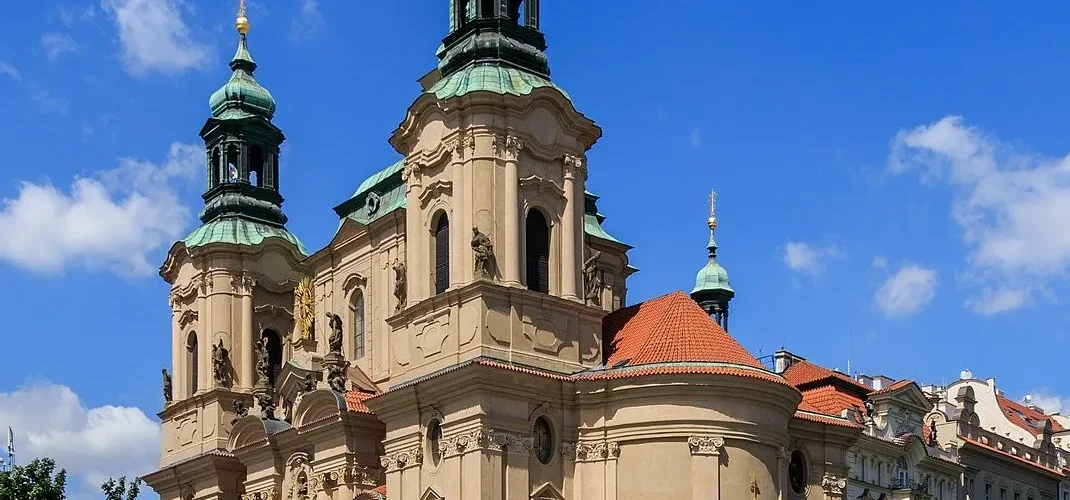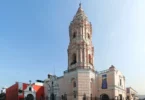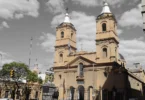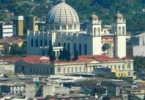
Introduction
Maria Geburt , also Mariä Geburt , is a Catholic parish church built in 1894/95 in the Aschaffenburg district of Schweinheim. Ecclesiastically, Schweinheim belonged to the Aschaffenburg parish of Our Lady . The first chapel in Hain, as Schweinheim was then called, dates from around 1660. It was 40 feet long, 32 feet wide, 25 feet high, the choir 10 feet deep, and covered with tiles with a ridge turret with two bells. The patron saint of the church was St. Alban of Mainz , whose memorial day is celebrated on June 21st. In 1756, the church was rebuilt and expanded; the foundation stone was found when the church was demolished.
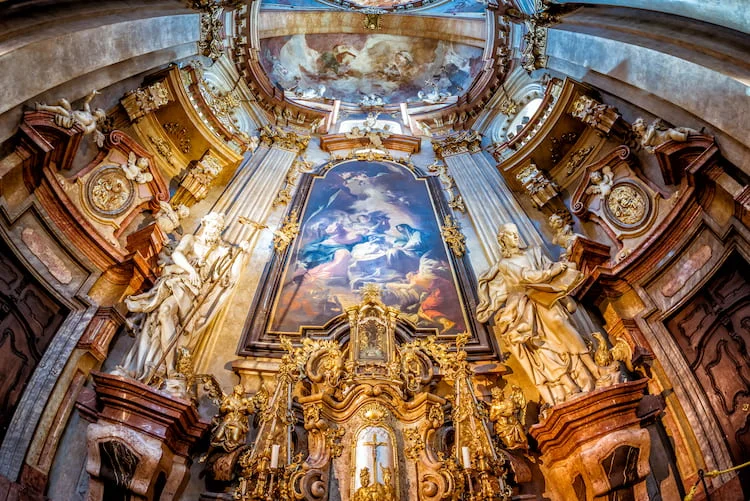
The original Gothic Parish church of Saint Nicholas which dated from the 13th century, stood on the site of the present church. Sometime after 1620, it was given to the Jesuits, and the parish transferred to St. Václav’s Church. In 1628, they opened a primary school and a junior secondary school.
In the second half of the 17th century the Jesuits decided to build a new church designed by Giovanni Domenico Orsi. A partial impression of the original planned appearance of the church is provided by the Chapel of St Barbara, which was built first so that mass could be celebrated. Old Saint Nicholas was demolished and in 1673 the cornerstone laid for the new church. The church was built in two stages during the 18th century. From 1703 till 1711 the west façade, the choir, the Chapels of St Barbara and St Anne were built.
Count Wenceslaus Kolowrat-Liebsteinsky (1634 – 6 October 1659) from the prominent Czech House of Kolowrat was the largest patron of The church of St. Nicholas. He donated his entire estate, worth 178,500 gold, for the construction of the church and the adjacent buildings in Prague in Malá Strana.
The new plans involved an intricate geometrical system of interconnected cylinders with a central dome above the transept. The massive nave with side chapels and an undulating vault based on a system of intersecting ellipsoids was apparently built by Christoph Dientzenhofer. The pillars between the wide spans of the arcade supporting the triforium were meant to maximize the dynamic effect of the church. The chancel and its characteristic copper cupola were built in 1737–1752, this time using plans by Christoph’s son, Kilian Ignaz Dientzenhofer.
In 1752, after Dientzenhofer’s death in 1751, the construction of the church tower was completed. During the years the church continued to expand its interior beauty. Following the abolition of the Jesuit Order by Pope Clement XIV, St Nicholas became the main parish church of the Lesser Town in 1775.
During the communist era the church tower was used as an observatory for State Security since from the tower it was possible to keep watch on the American and Yugoslav embassies and the access route to the West German embassy.
The history of the Church of St Nicholas of Prague began long before its construction. It is known that as far back as the thirteenth century, the site on which it stands was dedicated to religious use, as it housed a small Romanesque-style parish church. Later, the parish church was acquired by the municipal authority, and served as a council chamber until the Old Town Hall was built in 1338. The church also accepted the preachings of Reformist thinkers such as Jan Milíč and Jan Hus, both of whom were deeply critical of the Catholic Church at that time. Later, the outbreak of the Thirty Years’ War (1618-1648)—and the subsequent Catholic victory over Czech territories—resulted in the parish church coming under the control of the Benedictine Order. Only after the church was destroyed by a fire in 1689, did the monks order the building of the Baroque church we know today.
Completed in 1737 by the German architect Dientzenhofer, the church over the next 100 years switched between its religious function and other more diverse uses, such as a granary and a general archive. Between 1871 and 1914, the church was taken over by the Russian Orthodox community, and later it was used as a military chapel during the Second World War. After the war, the Church of St Nicholas passed into the hands of its current owner, the Hussite Church.
Architecture of St. Nicholas Church, Prague, Czechia
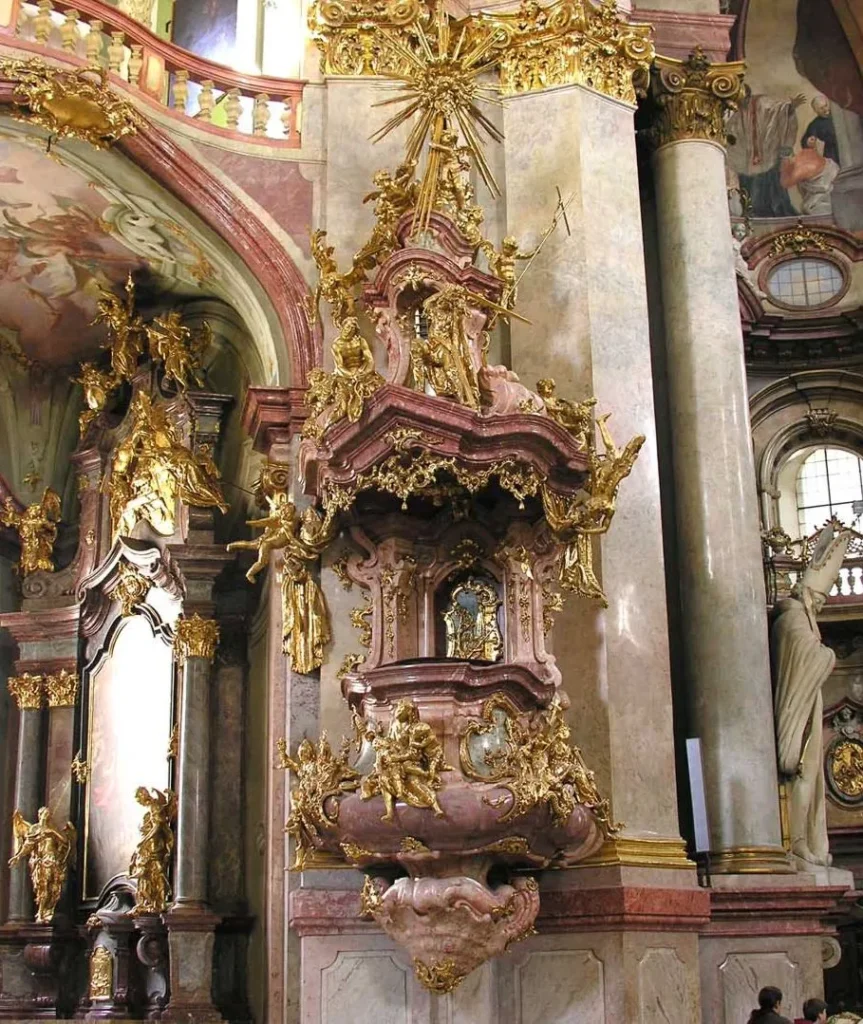
It has been described as “the most impressive example of Prague Baroque” and “without doubt the greatest Baroque church in Prague and the Dientzenhofers’ supreme achievement”.
On the shield is a sign of the alleged patron of the building Frantisek Karel Count of Kolowrat-Liebsteinsky. The mark of the actual patron Václav Count of Kolowrat-Liebsteinsky on the facade of the temple is not found. He was so humble that he did not want his name to be associated with the building, and after the completion of the building the coat of arms of his uncle were used.
The church excels not only in the architecture, but also in the decoration, external facade is brownish color, mainly with the frescos by Jan Lukas Kracker and a fresco inside the 70 m high dome by František Xaver Palko. The interior is further decorated with sculptures by František Ignác Platzer.
The Baroque organ has over 4,000 pipes up to six metres in length and was played by Mozart in 1787. Mozart’s spectacular masterpiece, Mass in C, was first performed in the Church of Saint Nicholas shortly after his visit.
The 79 m tall belfry is directly connected with the church’s massive dome. The belfry with great panoramic view, was unlike the church completed in Rococo forms in 1751–1756 by Anselmo Lurago.
The main entrance to the Church of St Nicholas stands on one side of the square whose centre is dominated by a statue of Jan Hus. With its Baroque style and its vast proportions—it reaches 46 metres at its highest point—this Hussite church stands out on Prague’s skyline, thanks to its cupola and its two tall towers set off with lights. An interesting fact: until 1904, just one of the towers had a staircase, so the other tower could only be reached by means of a mobile wooden bridge suspended between the towers.
Other outstanding features of the façade of the Church of St Nicholas are the numerous statues of Benedictine saints carved in sandstone which Antonín Braun, the renowned Tyrolean sculptor, created especially for the Church between 1732 and 1737.
The facade of the temple is a typical example of buildings in the so-called radical or dynamic baroque style. Curved walls heavily divided by pillars and cornices create the illusion of movement. The facade is richly decorated with sculptures. Above the entrance, there is a sculpture of St. Nicholas. On both sides of him, St. Peter and St. Paul are standing. On the very edges are the founders of the Jesuit order – St. Ignatius of Loyola and St. Francis Xavier.
The church’s exterior is equally captivating, with its striking bell tower & intricate detailing. The elegant facade reflects the grandeur and artistic prowess of the Baroque era.
Church Interior

The church’s interior, the German architect Kilian Dientzenhofer drew inspiration from the palace of Les Invalides in Paris, which was famous as the final resting place of Emperor Napoleon Bonaparte I. On stepping into the church, we can immediately marvel at the cupola and the frescoes—showing scenes from the life of St Nicholas—which cover the walls. A spectacular Bohemian glass lamp, weighing 1,400 kilograms, hangs from the cupola, a gift from the Tsar of Russia to the Orthodox Church in the late nineteenth century. The walls are lavishly decorated with stucco murals by Bernard Spinetti, and the High Altar, which is made from artificial marble, stands imperiously at the far end of the nave. If we look carefully, we can even see that a few of the lower domes still retain fragments saved from the fire in the earlier Romanesque church.
The interiors of the church are even more impressive. Franz Xaver Palko created the mural in the dome with the illusion of dizzying high. Some sketches of this mural are kept in the Louvre. The dome rests on four massive pillars. Fathers of the Church and symbols of human qualities – sculptures of Ignaz Platzer – are looking down at us.
Feast Day
Feast day : 6th December
The feast day of St. Nicholas Church in Prague, Czechia, is celebrated on December 6th, honoring St. Nicholas.
Church Mass Timing
Every Sunday : 8.30 PM
Church Opening Time
Sunday to Thursday : 09:00am – 05:45pm
Friday and Saturday : 09:00am – 04:45pm
Contact Info
Address:
Malostranské náměstí, 118 00, Malá Strana, Praha 1
Phone : +420 257 534 215
Accommodations
Connectivities
Airway
Prague Airport (PRG) to St. Nicholas Church distance 14.3 km(36mins).
Railway
Prague Main Station to St. Nicholas Church distance 14 min (5.0 km) via nábř. E. Beneše.

